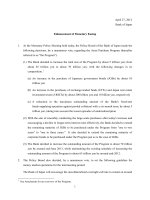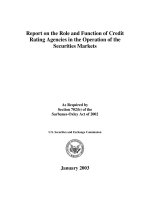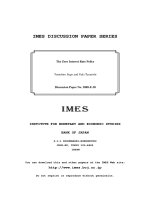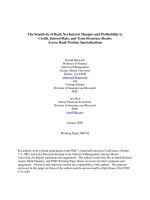Enhancement of Monetary Easing Bank of Japan potx
Bạn đang xem bản rút gọn của tài liệu. Xem và tải ngay bản đầy đủ của tài liệu tại đây (66.43 KB, 5 trang )
1
April 27, 2012
Bank of Japan
Enhancement of Monetary Easing
1. At the Monetary Policy Meeting held today, the Policy Board of the Bank of Japan made the
following decisions, by a unanimous vote, regarding the Asset Purchase Program (hereafter
referred to as "the Program").
(1) The Bank decided to increase the total size of the Program by about 5 trillion yen, from
about 65 trillion yen to about 70 trillion yen, with the following changes in its
composition.
1
(a) An increase in the purchase of Japanese government bonds (JGBs) by about 10
trillion yen
(b) An increase in the purchases of exchange-traded funds (ETFs) and Japan real estate
investment trusts (J-REITs) by about 200 billion yen and 10 billion yen, respectively
(c) A reduction in the maximum outstanding amount of the Bank's fixed-rate
funds-supplying operation against pooled collateral with a six-month term, by about 5
trillion yen, taking into account the recent episodes of undersubscription
(2) With the aim of smoothly conducting the large-scale purchases after today's increase and
encouraging a decline in longer-term interest rates effectively, the Bank decided to extend
the remaining maturity of JGBs to be purchased under the Program from "one to two
years" to "one to three years." It also decided to extend the remaining maturity of
corporate bonds to be purchased under the Program just as is the case of JGBs.
(3) The Bank decided to increase the outstanding amount of the Program to about 70 trillion
yen by around end-June 2013, while maintaining the existing schedule of increasing the
outstanding amount of the Program to about 65 trillion yen by around end-2012.
2. The Policy Board also decided, by a unanimous vote, to set the following guideline for
money market operations for the intermeeting period:
The Bank of Japan will encourage the uncollateralized overnight call rate to remain at around
1
See Attachment for an overview of the Program.
2
0 to 0.1 percent.
3. Looking at economic developments overseas, a risk of the European debt problem causing
financial market turmoil has decreased and the U.S. economy has continued to recover at a
moderate pace. Against this background, although Japan's economic activity has remained
more or less flat, it has become increasingly evident that the economy is shifting toward a
pick-up phase as positive developments have become widespread. As examined in the
Outlook for Economic Activity and Prices (Outlook Report) to be released today, Japan's
economy is expected to return to a moderate recovery path as the pace of recovery in
overseas economies picks up, led by emerging and commodity-exporting economies, and as
reconstruction-related demand after the earthquake disaster gradually strengthens. As the
aggregate supply and demand balance improves, the year-on-year rate of change in the CPI is
expected to gradually rise to a range of above 0.5 percent and less than 1 percent toward the
latter half of the projection period in the Outlook Report. Thereafter, it will likely be not too
long before the rate reaches the Bank's "price stability goal in the medium to long term" of 1
percent for the time being. It is likely that Japan's economy will return to a sustainable
growth path with price stability in the longer run.
4. The Bank has been pursuing powerful monetary easing, with its virtually zero interest rate
policy and implementation of the Program mainly through the purchase of financial assets.
Such measures by the Bank have been supporting economic activity by encouraging a decline
in longer-term interest rates and risk premiums, as well as by maintaining financial market
stability. By continuing to pursue monetary easing with the virtually zero interest rate
policy, easing effects are expected to strengthen on the back of progress in economic recovery.
The Bank expects that, together with the cumulative effects of earlier policy measures,
today's decision to further enhance monetary easing will better ensure the return of Japan's
economy to a sustainable growth path with price stability.
5. In pursuing the above powerful monetary easing, the Bank will verify that there is no
significant risk to the sustainability of economic growth, such as from the accumulation of
financial imbalances. Given that the Bank pursues powerful monetary easing in a severe
fiscal situation, it is extremely important to maintain credibility in fiscal sustainability in
financial markets, for the sake of effective transmission of the effects of monetary policy,
financial system stability, and sustainable economic growth.
6. In order to overcome deflation, it is crucial to tackle the long-term structural challenge of
declining trend growth rates amid rapid population aging. In order to overcome this
3
challenge and establish a new basis for economic growth, business firms need to become
more innovative in an effort to add value to their activities and explore new sources of
demand both at home and abroad. With the aim of supporting such positive movements by
firms, the government should seek to create a more conducive environment and private
financial institutions should make efforts to strengthen the foundation for economic growth.
As described above, the goal of overcoming deflation will be achieved through such
continued efforts by business firms, financial institutions, the government, and the Bank
within their respective roles.
4
Attachment
Increase in the Asset Purchase Program
(trillion yen)
Program size
at the time of
establishment
Program size
before
the increase
Program size after
the increase
Change in
amount
[Intended time to
complete the increase]
[End-December
2011]
[End-December
2012]
[End-December
2012]
[End-June
2013]
(
A
)
(
B
)
(
B
)
-
(
A
)
Total size About 35 About 65 About 65 About 70 About +5
Asset purchases 5.0 30.0 35.0 4
0
.0 +10.0
Japanese government
bonds
[Note 1]
1.5 19.0 2
4
.0 29.0 +10.0
Treasury discount bills 2.0
4
.5
4
.5
4
.5
―
CP
0
.5 2.1 2.1 2.1
―
Corporate bonds
0
.5 2.9 2.9 2.9
―
Exchange-traded
funds (ETFs)
[Note 2]
0
.45 1.4 1.6 1.6 +0.2
Japan real estate
investment trusts
(J-REITs)
[Note 2]
0
.05 0.11
0
.12
0
.12 +0.01
Fixe
d
-rate
funds-supplying
operation against pooled
collateral
3
0
.0 35.0 3
0
.0 3
0
.0 -5.0
Three-month term 2
0
.0 20.0 2
0
.0 2
0
.0
―
Six-month term 1
0
.0 15.0 1
0
.0 1
0
.0 -5.0
Notes: 1. In addition to purchases under the Asset Purchase Program, the Bank regularly purchases Japanese government
bonds at the pace of 21.6 trillion yen per year.
2. The increases in the purchases of ETFs and J-REITs are conditional on obtaining authorization in accordance with
the Bank of Japan Act.
(Reference)
Meeting hours:
April 27: 8:59-12:41
Policy Board members present:
Masaaki Shirakawa (Governor)
Hirohide Yamaguchi (Deputy Governor)
Kiyohiko G. Nishimura (Deputy Governor)
Ryuzo Miyao
Yoshihisa Morimoto
Sayuri Shirai
Koji Ishida
(Others present)
From the Ministry of Finance:
Mitsuo Mitani, Parliamentary Secretary for Finance (8:59-12:25,12:31-12:41)
From the Cabinet Office:
Hiroshi Ogushi, Parliamentary Secretary of Cabinet Office
(8:59-12:25,12:31-12:41)
Release of the minutes:
8:50 on Monday, May 28









